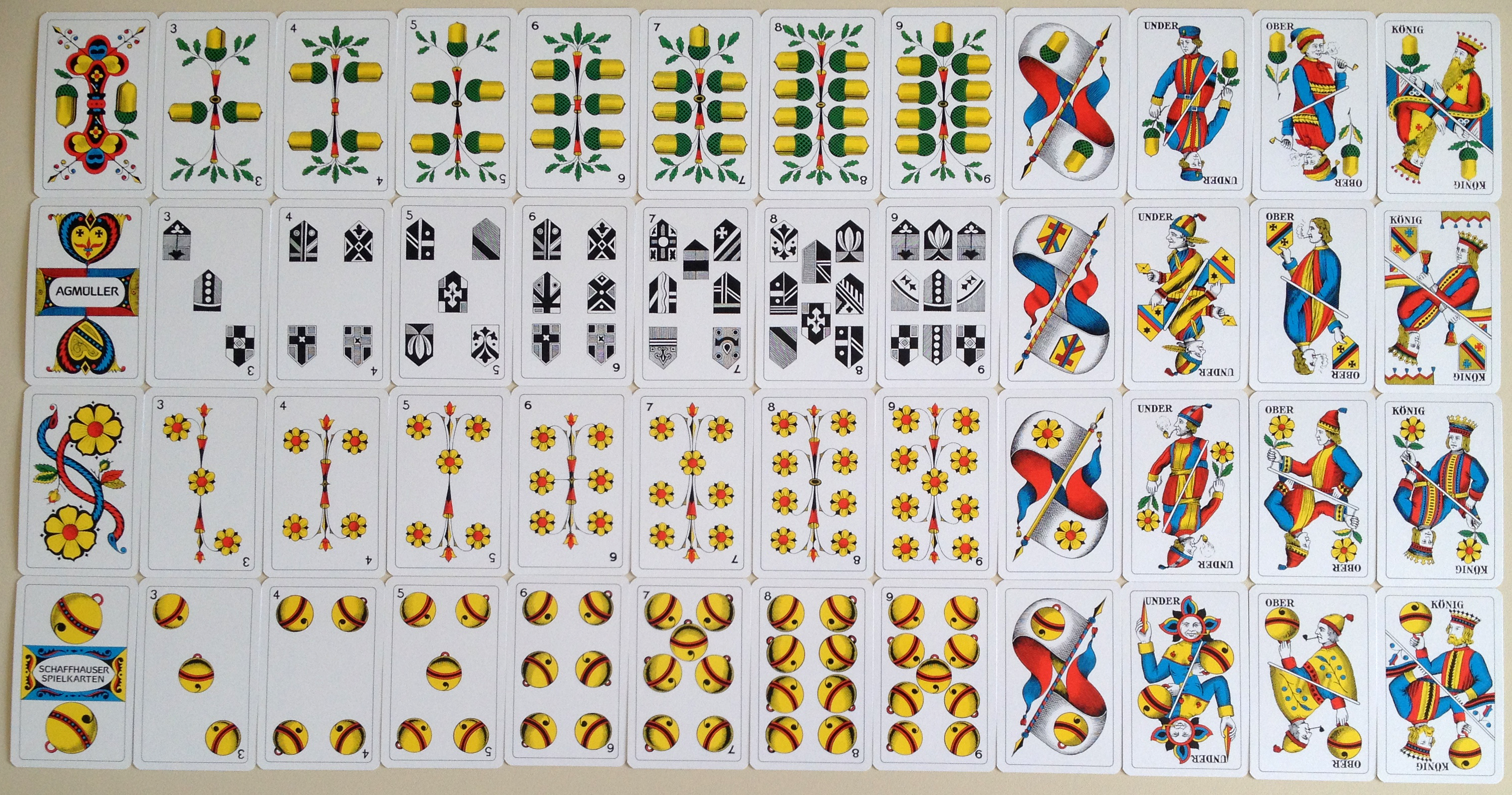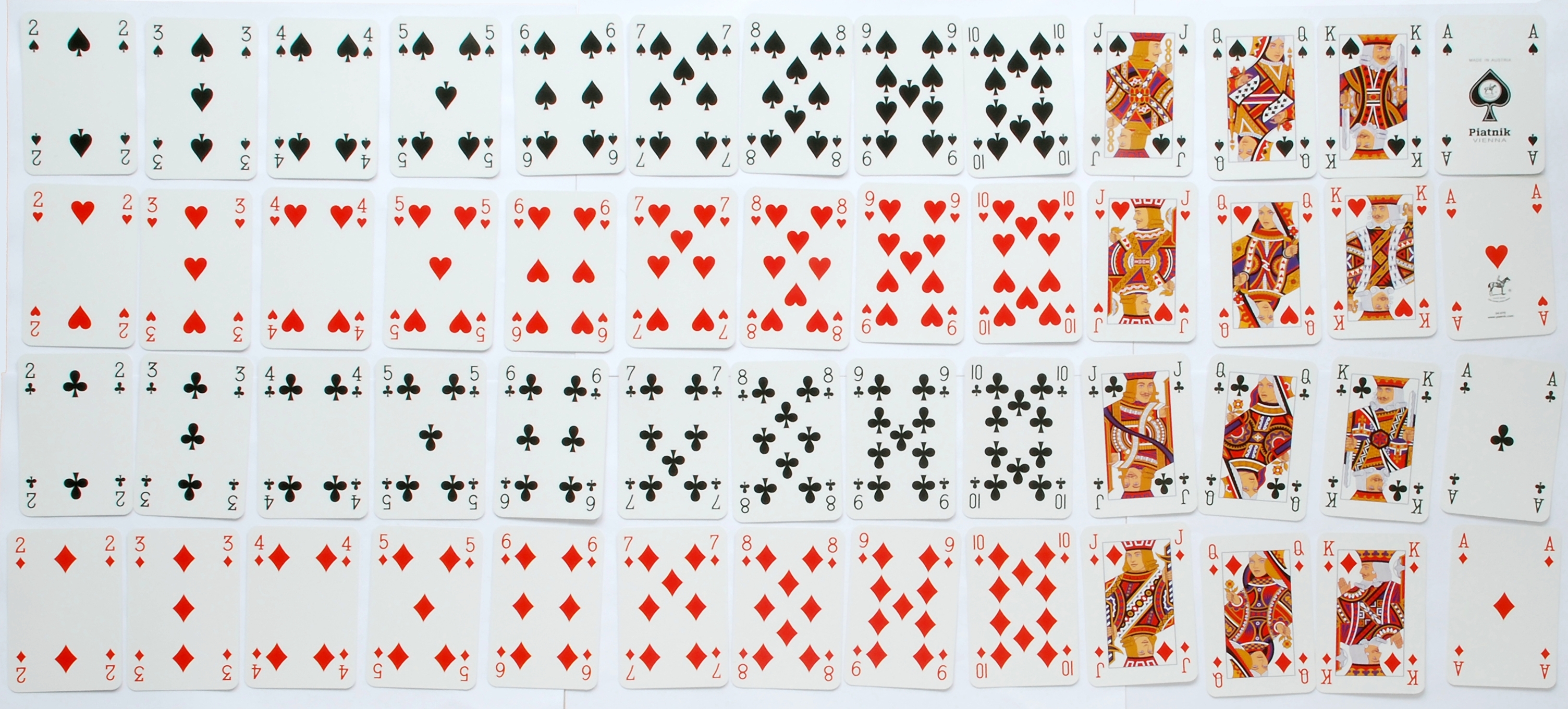|
Knüffeln
Knüffeln is a very old trick-taking game, trick-taking card game for four players, playing in pairs, that is still played in North Germany. Once considered the national game of Frisia, Knüffeln is a descendant of Karnöffel, the oldest identifiable European card game in the history of playing cards with a continuous tradition of play down to the present day. Knüffeln, itself several centuries old, became popular in Frisia in North Germany and, despite being described in 1924 as in danger of extinction, is still taught and played in North Frisia. Like its parent, it uses a 48-card pack, has a highly unusual hierarchy and cards with special properties, including the "surprising feature" of two chosen suits whose cards have a range of trump-like powers or no powers at all.Dummett (1980), pp. 185–187. Another oddity is that partners are allowed to openly communicate with one another and try to bluff the opposition about their hands and each side has a 'director' who may instru ... [...More Info...] [...Related Items...] OR: [Wikipedia] [Google] [Baidu] |
German Solo
German solo or just solo is a German 8-card plain-trick game for 4 individual players using a 32-card, German- or French-suited skat pack. It is essentially a simplification of quadrille, itself a 4-player adaptation of ombre.''Neuestes Spielbuch'' (1834), pp. 116–128. As in quadrille, players bid for the privilege of declaring trumps and deciding whether to play alone or with a partner. Along with ombre, Tarock and Schafkopf, German solo influenced the development of skat.Hoffmann & Dietrich (1982). Parlett calls it a "neat little descendant of Quadrille" and "a pleasant introduction" to the ombre family of games. Name The game is often called German solo in English and German sources to distinguish it from other national games such as American solo, Spanish solo and English solo. However, it was often known locally just as solo or, in the Münsterland, as Sollo. Historically it was also referred to as German ombre and some American publications actually call the ga ... [...More Info...] [...Related Items...] OR: [Wikipedia] [Google] [Baidu] |
Karnöffel
Karnöffel is a trick-taking card game which probably came from the upper-German language area in Europe in the first quarter of the 15th century. It first appeared listed in a municipal ordinance of Nördlingen, Bavaria, in 1426 among the games that could be lawfully played at the annual city fête. This makes the game the oldest identifiable European card game in the history of playing cards with a continuous tradition of play down to the present day. History The earliest substantial reference to Karnöffel is a poem by Meissner, written in or before 1450. Historically ''karnöffeln'' meant "to cudgel, thrash or flog", but in medieval times, a ''Karnöffel'' was also the word for an inguinal hernia. Karnöffel had a suit, the 'chosen suit', in which some cards had a higher priority than cards in other suits, which indicates that it might be a possible precursor to the trump suit of Tarot. The earliest forms of Karnöffel utilized a deck of 48 cards, Aces having been removed ... [...More Info...] [...Related Items...] OR: [Wikipedia] [Google] [Baidu] |
Card Game
A card game is any game that uses playing cards as the primary device with which the game is played, whether the cards are of a traditional design or specifically created for the game (proprietary). Countless card games exist, including families of related games (such as poker). A small number of card games played with traditional decks have formally standardized rules with international tournaments being held, but most are folk games whose rules may vary by region, culture, location or from circle (cards), circle to circle. Traditional card games are played with a ''deck'' or ''pack'' of playing cards which are identical in size and shape. Each card has two sides, the ''face'' and the ''back''. Normally the backs of the cards are indistinguishable. The faces of the cards may all be unique, or there can be duplicates. The composition of a deck is known to each player. In some cases several decks are Shuffling, shuffled together to form a single ''pack'' or ''shoe''. Modern car ... [...More Info...] [...Related Items...] OR: [Wikipedia] [Google] [Baidu] |
Chosen Suit
The following is a glossary of terms used in card games. Besides the terms listed here, there are thousands of common and uncommon slang terms. Terms in this glossary should not be game-specific (e.g. specific to bridge, hearts, poker or rummy Rummy is a group of games related by the feature of matching playing cards, cards of the same rank or sequence and same suit. The basic goal in any form of rummy is to build ''Meld (cards), melds'' which can be either Set (cards), sets (three ...), but apply to a wide range of card games played with non-proprietary packs. It should not include terms solely related to casino or banking games. For glossaries that relate primarily to one game or family of similar games, see #Game-specific glossaries, Game-specific glossaries. A ; ace # The card with one pip in a pack of cards. Usually the highest card of a #suit, suit, #rank, ranking immediately above the #King, king. May also occupy the lowest rank. # Commonly refers to the #deuc ... [...More Info...] [...Related Items...] OR: [Wikipedia] [Google] [Baidu] |
Trump (cards)
A trump is a playing card which is elevated above its usual rank in trick-taking games. Typically an entire suit is nominated as a ''trump suit''; these cards then outrank all cards of plain (non-trump) suits. In other contexts, the terms ''trump card'' or ''to trump'' refers to any sort of action, authority or policy which automatically prevails over all others. The introduction of trumps is one of only two major innovations to trick-taking games since they were invented; the other being the idea of bidding. Trump cards, initially called '' trionfi'', first appeared with the advent of Tarot cards in which there is a separate, permanent trump suit comprising a number of picture cards. The first known example of such cards was ordered by the Duke of Milan around 1420 and included 16 trumps with images of Greek and Roman gods. Around the same time that Tarot cards were invented with the purpose of adding a trump suit to the existing four suits, a similar concept arose in the g ... [...More Info...] [...Related Items...] OR: [Wikipedia] [Google] [Baidu] |
Kaiserspiel
Kaiserspiel, also called Kaisern or Cheisärä, is a card game, usually for 4 or 6 players, that is played in parts of Switzerland using a variant of the standard Swiss playing cards with 40 or 48 cards. It is a descendant of Karnöffel, one of the oldest card games known.''Kaiserspiel'' at www.pagat.com. Retrieved 4 Jun 2018. It is sometimes misleadingly called ''Kaiserjass'', although it has nothing to do with the family of games that are popular in Switzerland. Cards The Kaiserspiel pack comprises four suits: , |
Matador (cards)
The following is a glossary of terms used in card games. Besides the terms listed here, there are thousands of common and uncommon slang terms. Terms in this glossary should not be game-specific (e.g. specific to bridge, hearts, poker or rummy), but apply to a wide range of card games played with non-proprietary packs. It should not include terms solely related to casino or banking games. For glossaries that relate primarily to one game or family of similar games, see Game-specific glossaries. A ; ace # The card with one pip in a pack of cards. Usually the highest card of a suit, ranking immediately above the king. May also occupy the lowest rank. # Commonly refers to the Deuce or Two in German-suited packs which don't have real Aces. Often the highest card of a suit. ; acorns : One of the four suits in a German-suited pack of cards. Symbol: ; active # A card that is in play i.e. not sleeping. # See active player. ; active player # A player who receives car ... [...More Info...] [...Related Items...] OR: [Wikipedia] [Google] [Baidu] |
North Frisia
North Frisia (; ; ; ; ) is the northernmost portion of Frisia, located in Schleswig-Holstein, Germany, between the rivers Eider River, Eider and Vidå, Wiedau. It also includes the North Frisian Islands and Heligoland. The region is traditionally inhabited by the North Frisians. History Ancient settlements The geestland islands along the North Frisian coastline were already densely settled in the time of the early Roman Empire while the marshes further inland were not suited for settling. Only a few ancient marshland settlements have been found during archaeological excavations, namely in the modern area of southern Sylt, the Wiedingharde and along the southern Eiderstedt peninsula. With the beginning of the Migration Period, the number of settlements in North Frisian became ever lesser and many were totally abandoned. A new increase in population in the 8th century has been attributed to immigration but it is thought that the area had not been completely depopulated before.K ... [...More Info...] [...Related Items...] OR: [Wikipedia] [Google] [Baidu] |
Trick (cards)
Trick(s) may refer to: People * Trick McSorley (1852–1936), American professional baseball player * Armon Trick (born 1978), retired German international rugby union player * David Trick (born 1955), former Ontario civil servant and university administrator * Marcus Trick (born 1977), retired German international rugby union player * Stanley Arthur Trick (1884–1958), English cricketer for Essex * Stephanie Trick (born 1987), American stride, ragtime and jazz pianist * Trick Daddy (born 1974), American rapper and producer * Trick-Trick (born 1973), Detroit rapper * Junaid Hussain (1994–2015), British hacker and propagandist who used the alias TriCk Arts, entertainment, and media Films * ''Tricks'' (1925 film), American silent film * ''Trick'' (1999 film), American gay romantic-comedy * ''Tricks'' (1997 film), TV movie; see Jay Friedkin * ''Tricks'' (2007 film), Polish film by Andrzej Jakimowski * ''Trick'' (2010 film), Polish film by Jan Hryniak * ''Trick'' ... [...More Info...] [...Related Items...] OR: [Wikipedia] [Google] [Baidu] |
Berlin Pattern
French-suited playing cards or French-suited cards are cards that use the French suits of (clovers or clubs ), (tiles or diamonds ), (hearts ), and (pikes or spades ). Each suit contains three or four face/court cards. In a standard 52-card deck these are the ( knave or jack), the ( lady or queen), and the (king). In addition, in Tarot packs, there is a (knight) ranking between the queen and the jack. Aside from these aspects, decks can include a wide variety of regional and national patterns, which often have different deck sizes. In comparison to Spanish, Italian, German, and Swiss playing cards, French cards are the most widespread due to the geopolitical, commercial, and cultural influence of France, the United Kingdom, and the United States in the 19th and 20th centuries. Other reasons for their popularity were the simplicity of the suit insignia, which simplifies mass production, and the popularity of whist and contract bridge. The English patte ... [...More Info...] [...Related Items...] OR: [Wikipedia] [Google] [Baidu] |
Hahnrei
Hahndreier or Hanrei is an 18th-century Danish and north German children's and family round game played with cards that is still played in some forms today. Name The game is recorded under numerous different spellings in the literature including: ''Hahndrei, Hahndrei um’n lüchter, Hahndreier um’n lüchter, Hahndreier, Hahndreih, Hahndreiher, Hahnendreher um Schluck, Hahnenrei, Hahnrei, Hahnrei mit Naklapp, Hahnrei-Racker, Hahnrei un Racker, Hahnrei up'n Barg, Hahnrei verdeckt, Hahnreier, Hohn, Hohnendreier um Sluk, Hohnendreier um een Schluch.'' Variants include ''bedregn, bedregen or bedreegten Hahnrei, neIi Hahn, Nieschierei'' and ''verdeckten Hahnrei''. Another name is ''Racker''. History As Hahnrey, it appears in a list of games embedded in a poem by Johann Christian Trömer in 1755. In 1795 it was clearly well known in Livonia and Estonia, being equated by Hupel to the Russian game of Durak. In the 19th century, it was found all across northern Germany. For exam ... [...More Info...] [...Related Items...] OR: [Wikipedia] [Google] [Baidu] |




